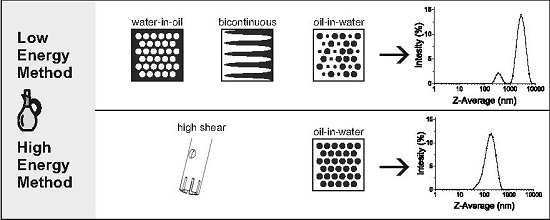Molecules. 2017 Apr 27;22(5). pii: E700. doi: 10.3390/molecules22050700.
Abstract
 The formulation, characterization, and anticipated antibacterial properties of hemp seed oil and its emulsions were investigated. The oil obtained from the seeds of Cannabis sativa L. in refined and unrefined form was characterized using iodine, saponification, acid values, and gas chromatography, and was employed for the preparation of stable oil-in-water emulsions. The emulsions were prepared using pairs of non-ionic surfactants (Tween, Span). The effects of the emulsification method (spontaneous emulsification vs. high-intensity stirring), hydrophilic lipophilic balance (HLB), type and concentration of surfactant, and oil type on the size and distribution of the emulsion particles were investigated. It was found that the ability to form stable emulsions with small, initial particle sizes is primarily dependent on the given method of preparation and the HLB value. The most efficient method of emulsification that afforded the best emulsions with the smallest particles (151 ± 1 nm) comprised the high-energy method, and emulsions stable over the long-term were observed at HBL 9 with 10 wt % concentration of surfactants. Under high-intensity emulsification, refined and unrefined oils performed similarly. The oils as well as their emulsions were tested against the growth of selected bacteria using the disk diffusion and broth microdilution methods. The antibacterial effect of hemp seed oil was documented against Micrococcus luteus and Staphylococcus aureus subsp. aureus. The formulated emulsions did not exhibit the antibacterial activity that had been anticipated.
The formulation, characterization, and anticipated antibacterial properties of hemp seed oil and its emulsions were investigated. The oil obtained from the seeds of Cannabis sativa L. in refined and unrefined form was characterized using iodine, saponification, acid values, and gas chromatography, and was employed for the preparation of stable oil-in-water emulsions. The emulsions were prepared using pairs of non-ionic surfactants (Tween, Span). The effects of the emulsification method (spontaneous emulsification vs. high-intensity stirring), hydrophilic lipophilic balance (HLB), type and concentration of surfactant, and oil type on the size and distribution of the emulsion particles were investigated. It was found that the ability to form stable emulsions with small, initial particle sizes is primarily dependent on the given method of preparation and the HLB value. The most efficient method of emulsification that afforded the best emulsions with the smallest particles (151 ± 1 nm) comprised the high-energy method, and emulsions stable over the long-term were observed at HBL 9 with 10 wt % concentration of surfactants. Under high-intensity emulsification, refined and unrefined oils performed similarly. The oils as well as their emulsions were tested against the growth of selected bacteria using the disk diffusion and broth microdilution methods. The antibacterial effect of hemp seed oil was documented against Micrococcus luteus and Staphylococcus aureus subsp. aureus. The formulated emulsions did not exhibit the antibacterial activity that had been anticipated.
KEYWORDS:
antibacterial activity; emulsion; fatty acid composition; hemp seed oil; particle size
- PMID: 28448475
- DOI: 10.3390/molecules22050700
-
LinkOut – more resources



